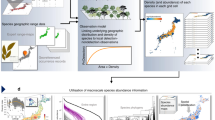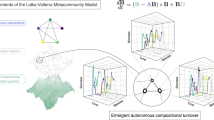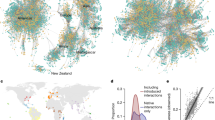Abstract
The theory of island biogeography1 asserts that an island or a local community approaches an equilibrium species richness as a result of the interplay between the immigration of species from the much larger metacommunity source area and local extinction of species on the island (local community). Hubbell2 generalized this neutral theory to explore the expected steady-state distribution of relative species abundance (RSA) in the local community under restricted immigration. Here we present a theoretical framework for the unified neutral theory of biodiversity2 and an analytical solution for the distribution of the RSA both in the metacommunity (Fisher's log series) and in the local community, where there are fewer rare species. Rare species are more extinction-prone, and once they go locally extinct, they take longer to re-immigrate than do common species. Contrary to recent assertions3, we show that the analytical solution provides a better fit, with fewer free parameters, to the RSA distribution of tree species on Barro Colorado Island, Panama4, than the lognormal distribution5,6.
This is a preview of subscription content, access via your institution
Access options
Subscribe to this journal
Receive 51 print issues and online access
$199.00 per year
only $3.90 per issue
Buy this article
- Purchase on Springer Link
- Instant access to full article PDF
Prices may be subject to local taxes which are calculated during checkout

Similar content being viewed by others
References
MacArthur, R. H. & Wilson, E. O. The Theory of Island Biogeography (Princeton Univ. Press, Princeton, NJ, 1967)
Hubbell, S. P. The Unified Neutral Theory of Biodiversity and Biogeography (Princeton Univ. Press, Princeton, NJ, 2001)
McGill, B. J. A test of the unified neutral theory of biodiversity. Nature 422, 881–885 (2003)
Condit, R. et al. Beta-diversity in tropical forest trees. Science 295, 666–669 (2002)
Preston, F. W. The commonness and rarity of species. Ecology 29, 254–283 (1948)
May, R. M. Ecology and Evolution of Communities 81–120 (Harvard Univ. Press, Cambridge, MA, 1975)
Bell, G. Neutral macroecology. Science 293, 2413–2418 (2001)
Diamond, J. & Case, T. J. (eds) Community Ecology (Harper and Row, New York, NY, 1986)
Tilman, D. Plant Strategies and the Dynamics and Structure of Plant Communities (Princeton Univ. Press, Princeton, NJ, 1988)
Weiher, E. & Keddy, P. Ecological Assembly Rules: Perspectives, Advances, and Retreats (Cambridge Univ. Press, Cambridge, UK, 1999)
Boswell, M. T., Ord, J. K. & Patil, G. P. Statistical Distributions in Ecological Work 3–157 (International Co-operative Publishing, Fairland, MD, 1979)
Caraco, T. Statistical Distributions in Ecological Work 371–387 (International Co-operative Publishing, Fairland, MD, 1979)
Feller, W. An Introduction to Probability Theory and Its Applications Vol. 1 (John Wiley & Sons, Hoboken, NJ, 1968)
Van Kampen, N. G. Stochastic Processes in Physics and Chemistry (Amsterdam, North-Holland, 2001)
Fisher, R. A., Corbet, A. S. & Williams, C. B. The relation between the number of species and the number of individuals in a random sample of an animal population. J. Anim. Ecol. 12, 42–58 (1943)
Morse, P. M. & Feshbach, H. Methods of Theoretical Physics Part 1 (McGraw-Hill, New York, NY, 1953)
Press, W. H., Flannery, B. P., Teukolsky, S. A. & Vetterling, W. T. Numerical Recipes in C: The Art of Scientific Computing (Cambridge Univ. Press, Cambridge, UK, 1993)
Sugihara, G., Bersier, L., Southwood, T. R. E., Pimm, S. L. & May, R. M. Predicted correspondence between species abundances and dendrograms of niche similarities. Proc. Natl Acad. Sci. USA 100, 5246–5251 (2003)
Chave, J., Muller-Landau, H. C. & Levin, S. A. Comparing classical community models: Theoretical consequences for patterns of diversity. Am. Nat. 159, 1–23 (2002)
Manokaran, N. et al. Stand Tables and Species Distributions in the Fifty Hectare Plot at Pasoh Forest Reserve (Forest Research Institute Malaysia, Kuala Lumpur, 1992)
Kimura, M. Evolutionary rate at the molecular level. Nature 217, 624–626 (1968)
Ewens, W. J. The sampling theory of selectively neutral alleles. Theor. Pop. Biol. 3, 87–112 (1972)
Karlin, J. & McGregor, J. Addendum to a paper of W. Ewens. Theor. Pop. Biol. 3, 113–116 (1972)
Watterson, G. A. Models for the logarithmic species abundance distributions. Theor. Pop. Biol. 6, 217–250 (1975)
Kimura, M. & Ohta, T. Theoretical Aspects of Population Genetics (Princeton Univ. Press, Princeton, NJ, 1971)
Kimura, M. The Neutral Theory of Molecular Evolution (Cambridge Univ. Press, Cambridge, UK, 1983)
McKane, A., Alonso, D. & Solé, R. V. Mean-field stochastic theory for species-rich assembled communities. Phys. Rev. E 62, 8466–8484 (2000)
Rao, C. R. Statistical Ecology Vol. 1 Spatial Patterns and Statistical Distributions 131–142 (The Penn. State Univ. Press, University Park, PA, 1971)
Acknowledgements
We are grateful to O. Kargaltsev for a careful reading of the manuscript. This work was supported by NASA, by grants from the NSF, and by the Department of Plant Biology, University of Georgia.
Author information
Authors and Affiliations
Corresponding authors
Ethics declarations
Competing interests
The authors declare that they have no competing financial interests.
Rights and permissions
About this article
Cite this article
Volkov, I., Banavar, J., Hubbell, S. et al. Neutral theory and relative species abundance in ecology. Nature 424, 1035–1037 (2003). https://doi.org/10.1038/nature01883
Received:
Accepted:
Issue Date:
DOI: https://doi.org/10.1038/nature01883
This article is cited by
-
Taxonomic dependency and spatial heterogeneity in assembly mechanisms of bacteria across complex coastal waters
Ecological Processes (2024)
-
Life history complementarity and the maintenance of biodiversity
Nature (2023)
-
Environmental and spatial contributions to tree community assembly across life stages and scales in evergreen-deciduous broadleaf karst forests, southwest China
Journal of Forestry Research (2023)
-
Distinct Assembly Mechanisms for Prokaryotic and Microeukaryotic Communities in the Water of Qinghai Lake
Journal of Earth Science (2023)
-
Speciation in a MacArthur model predicts growth, stability, and adaptation in ecosystem dynamics
Theoretical Ecology (2023)
Comments
By submitting a comment you agree to abide by our Terms and Community Guidelines. If you find something abusive or that does not comply with our terms or guidelines please flag it as inappropriate.



